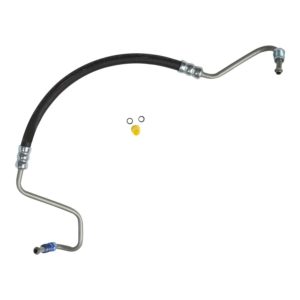My son’s Jeep was leaving oil stains in the driveway and making a howling noise when he turned the steering wheel. I popped the hood and had him turn the wheel. Sure enough, fluid was seeping through the hose when it was under pressure. There did not seem to be a definite hole, the rubber had just become porous with age.
Before I began, I coated my hands with Market America Clear Shield to protect me form the power steering fluid.
I began by obtaining a replacement hose. I could have had a new section of hose put on the old fittings at a hydraulic shop. However, it looked like one of the metal ends was kinked by a previous owner so I elected to replace the entire assembly. I bought one from a chain auto parts store so that he could easily swap it out if there was a warranty issue.
Since the hose had been leaking for a while, the area was very oily. I coated my hands in Market America Clear Shield to prevent oil stains on my skin.
First I removed the air filter box since the steering box is located below it. Next, using a 5/8 inch wrench (because I don’t own a full length 16MM open end,) I loosened the fitting at the pump.
The fitting at the steering box is 18 MM. It is very difficult to get to even with the air box out. Before removing it, make sure you remember how the hose is routed. Take a picture or make a drawing to make sure it goes back the right way. It may look like you have to remove the return line to remove the pressure line but you don’t. There is enough room to pull it out if you twist it correctly.
Next I installed new O rings on the new line. I was careful not to nick them as I used my fingers to slip them in place.
I installed the steering box end first but left it slightly loose so I could rotate the hose to the proper position to make the pump connection line up. I was very careful to not cross thread the lines when screwing them in place.
Next I installed the pump fitting. I held the line in the proper relationship as I made the final turn on the nut. I could feel the O ring seat. Then, I turned the box end the last turn and locked it down in place as well.
I filled the reservoir with the correct fluid. I then started the engine and turned the wheels from lock to lock a few times until I heard all the air purge out of the system. I then checked for leaks at the fittings and the crimps on the new hose.
I reinstalled the air box and replaced the various vacuum lines that had been knocked loose by moving the air box around. I am glad I caught it before the pump was damaged from running it low on fluid.
[phpbay]jeep power steering, 10[/phpbay]






